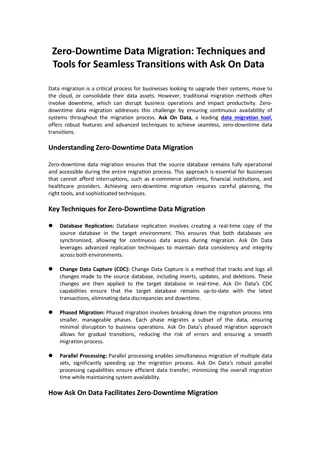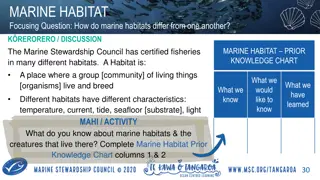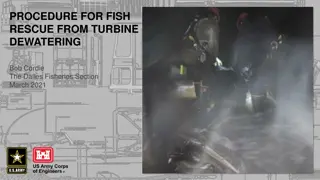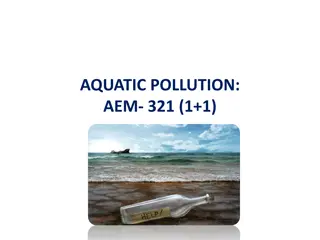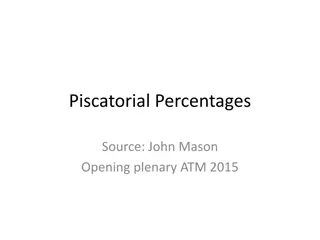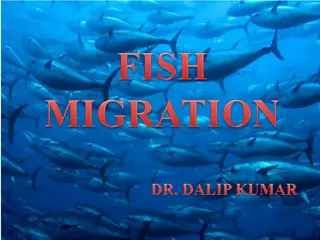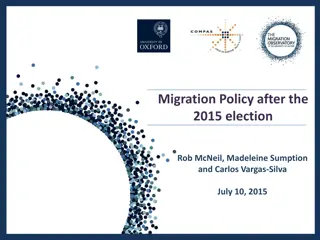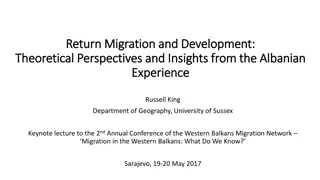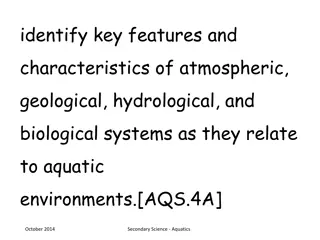Understanding Fish Migration and Behavior in Aquatic Habitats
Fish migration involves the movement of large numbers of fish for various reasons such as feeding, reproduction, and avoiding harsh weather conditions. Shoaling and schooling behaviors are observed in migrating fishes, with different types of migration including latitudinal, oceanodromous, potamodromous, catadromous, and anadromous migrations. Fishes live in both freshwater and marine habitats, exhibiting different migration patterns based on habitat changes. Various fish species exhibit unique migration behaviors based on their habitat preferences.
Download Presentation

Please find below an Image/Link to download the presentation.
The content on the website is provided AS IS for your information and personal use only. It may not be sold, licensed, or shared on other websites without obtaining consent from the author. Download presentation by click this link. If you encounter any issues during the download, it is possible that the publisher has removed the file from their server.
E N D
Presentation Transcript
Basic Terms Migration is the movement of large number of animals from one place to another for feeding, reproduction or to escape weather extremes. Shoaling:- When large no. of fishes come together and move socially, it is called as shoaling, Eg. Tuna, Anchovies. Schooling:-Migrating fishes exhibit high degree of coordination in their movements and carry out synchronized maneuvers to produce different types of shapes. This is called schooling.eg. Forage fishes
MIGRATION OF FISHES Long journeys taken by fishes from one place to another and back. Reasons for migration (i) Sexual maturity (ii) Hormones (iii) Instinct (iv) Predators and competition (v) Scarcity of food (vi) Abiotic factors like light, temperature, pH, water currents, etc.
Fishes live in two different types of aquatic habitats:- 1.Freshwater Habitat 2.Marine Habitat
Types of migration (i) Latitudinal migration north (spring) and south (autumn). (ii) Oceanodromous migration from native place to a far off place. Eg. Tunas, mackerels, etc. (iii) Potamodromous migration long movement within fresh water. Eg. Carps, trouts. (iv) Catadromous migration from fresh water to sea water for spawning (fresh water fishes). Eg. Eels. (v) Anadromous migration from sea water to fresh water (marine fishes). Eg. Salmons, Indian shad.
TYPE OF FISH MIGRATION Tunas (oceanodromous migration within sea) Sword fish (latitudinal migration ) Hilsa hilsa (anadromous migration Sea water to F.W) Carp & Trout(potamo droumous) Eel (catadromous migration F.W. to sea water )
FISH MIGRATION ON THE BASIS OF HABITAT CHANGE POTAMODROMOUS OCEANODROMOUS DIADROMOUS CATADROMOUS FROM FRESH WATER TO SEA WATER ANADROMOUS FROM SEA WATER TO FRESH WATER
Different types of fish migration on the basis of habitat: Potamodromous Migration:-When fishes migrate from one freshwater habitat to another in search of food or spawning, it is called as potamodromous migration. Fishes also migrate to lay eggs in places where oxygen concentration in water is more and where there is abundance of food for juveniles when they hatch from eggs. Example:- Common Asian Carps
Oceanodromous Migration:- This migration is from sea water to sea water. Example:-There are about 12,000 marine species that regularly migrate within sea like herrings, sardines, mackerels, cods, roaches and tunas. Diadromous migration:- When fishes can migrate from fresh water to sea water or from sea water to fresh water, it is called diadromous migration. It involves 120 species of fishes that are capable of overcoming osmotic barriers and migrate in these habitats.
Catadromous Migration:- This type of migration involves movement of large number of fishes from fresh water to sea water, generally for spawning as happens in the case of Anguilla(eels). Before migration the following changes take place in their bodies: They deposit large amount of fat in their bodies which serves as reserve food during the long journey. Color changes from yellow to metallic silvery grey. Digestive tract shrinks and feeding stops. Eyes are enlarged and vision sharpens. Other sensory organs also become sensitive. Skin becomes respiratory. Gonads get matured and enlarged. They become restless and develop strong urge to migrate in groups.
Eel migration (Catadromous migration) Four phases of life of Eel: (i) Adult yellow coloured eel (in rivers). (ii) Silver grey coloured eel (ready for migration). (iii)Pelagic larval phase (Leptocephali). (iv)Metamorphosis of pelagic larval phase to Elver s larva.
4 PHASES IN L.H OF EEL Adult yellow eel Silver grey eel ready for migration Larval phase of eel Metamorphosis Elver s larva
Anadromous Migration:- It involves migration of fishes from sea water to fresh water. Example:- Salmon and trout To maintain homeostasis, freshwater species have special adaptations for retaining ions and getting rid of excess water. 1. They actively take in ions across their gills and skin, a process that requires energy. 2. To get rid of excess water they excrete nitrogenous waste products in great quantities in the form of highly diluted urine.
Salmon migration (Anadromous migration) Marine fish, migrates to fresh water for breeding. In winter, pair of salmon migrates from sea water to fresh water and stop feeding. Then, sexual dimorphism appears and they spawn. After hatching, larval fish feed and migrate back to sea. Other anadromous fishes : acipenser, hilsa, alosa. Fishes showing seasonal migration Thunners (Tuna fish) in Mediterranean sea. Scomber (mackerel fish) in north Atlantic sea. Clupea (herring fish) in colder parts of Atlantic ocean.
Petromyzon (sea-lamprey) migration (Anadromous migration) They inhabit coastal waters of north America, Europe, West Africa and Japan. They ascend rivers in spring or early summer. A pair seeks clear, moderately fast flowing water, and builds a nest there. A single female can lay 236,000 eggs. Eggs hatch in about 3 weeks. Larval life extends from 5-8 year. Reaching the sea, they take to parasitic life.
SEA-LAMPREY (ANADROMOUS MIGRATION) Ammocete larvae in fresh water Adult lamprey attached to trout fish in sea water
DIADROMOUS MIGRATION Anadromous Migration Catadromous Migration
Other important facts Forage fish (prey fish) are small fish which are preyed upon by large predators for food. They migrate in schooling manner. Their schools become immense shoals which are concentrated fuel resources for the great marine predators.
Significance of fish migration Spawning To achieve better growth rates Greater reproductive success Temporal and spatial aggregations of fishes. To escape temperature extremes.



